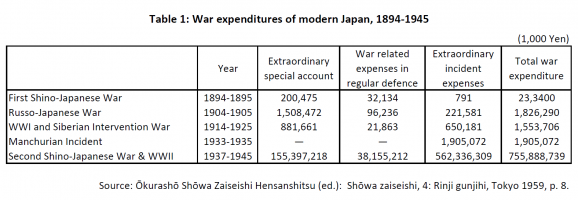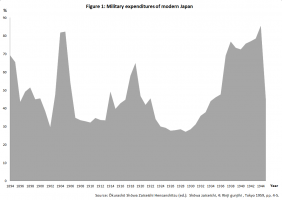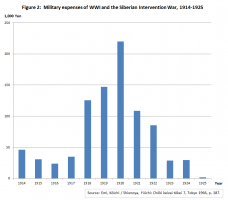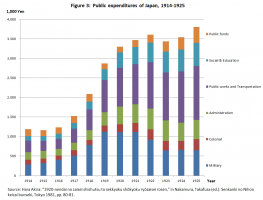Introduction↑
This article presents how the Japanese government raised money for World War I. Little attention has been paid to the Japanese war expenditures during World War I, with a few important exceptions such as the statistical analysis by Kōichi Emi and Yūichi Shionoya[1] and the fiscal institutional description by the Japanese Treasury,[2] because the impact of World War I on modern Japanese fiscal affairs tended to be underestimated, compared with other great wars such as the Russo-Japanese War and World War II. Summarizing war expenditures of modern Japanese governments in Section 1, the paper discusses the crucial role of the Special Account for Emergency War Expenditures in funding wars in Section 2; outlines the expenditures of the World War I period in Section 3; and shows sources of revenue for the war in Section 4; and thus offers a database for Japanese war expenditures. Lastly, the paper highlights a low rate of Japanese dependence on government bonds and loans throughout both World War I and the Siberian Intervention.
Military Expenditures and War Expenditures in Modern Japan↑
Defining “Military Expenditures” and “War Expenditures”↑
This paper understands “military expenditures” as being composed of both wartime and peacetime spending. These military expenditures can be broken down into the following categories: wartime expenses, or “war expenditures”; and peacetime expenses, including (1) “standing national defense spending”, which includes not only by the general account budget of the Army and Navy Ministries but also expenses associated with conscription; (2) “war connection costs”, or military aid and veterans’ pensions; and (3) interest paid on war bonds. “War expenditures” are not simple military expenditures. Instead, the term points to all the necessary direct costs incurred through the prosecution of the war and the post-war settlement. These costs include those incurred by the Special Account for Emergency War Expenditures, which covered the direct military campaign expenses and represented the core of overall spending; the budget’s general account extraordinary incident expenses, or the indirect war expenditures of every ministry outside the army and navy; and the Army and Navy Ministries’ extraordinary expenses for incidents, military affairs, and military backlog costs.
But it is difficult to define precisely the two terms “military expenditures” and “war expenditures”. Some researchers include military conscription costs in the category of direct war expenditures, so there exists a difference of opinion over what should be included in each of these categories. Moreover, we should not overlook the fact that as wars deepen into total wars, “war expenditures” and “military expenditures” become increasingly subsumed into the expenses covered by the general account of the national budget.
Military Expenditures in Modern Japan↑
From the Meiji Era until the end of World War II, military expenditures always occupied a high percentage of modern Japan’s governmental spending (see figure). Surprisingly, from the outbreak of the First Sino-Japanese War in 1894 until the end of World War II in 1945, the Japanese government spent money every single year on either war or post-war settlements. Further, during this fifty-year period, military expenditures always accounted for more than 25 percent of annual governmental spending.[3] Spending on military affairs substantially increased during the First Sino-Japanese War (1894-1895); the Russo-Japanese War (1904-1905); World War I and the Siberian Intervention (1914-1922); the Manchurian Incident (1931-1932); and the Second Sino-Japanese War and World War II (1937-1945). In these wars, wide-ranging military activities necessitated large war expenditures.
War Expenditures and the Special Account for Emergency War Expenditures in Modern Japan↑
The Special Account for Emergency War Expenditures played the most important role in covering modern Japan’s war costs. The Special Account was formed four times in history. It was established after the outbreak of four important wars that could decide Japan’s fate: the First Sino-Japanese War; the Russo-Japanese War; World War I and the Siberian Intervention; and the Second Sino-Japanese War and World War II. The Special Account was different from the general account of Japan’s national budget; the government specified that one “fiscal year” for the Special Account would last “from the incident’s beginning until its end”. During the Russo-Japanese War, for instance, this single fiscal year lasted for the forty-two months from 1 October 1904 to 31 March 1908. Moreover, the army and navy could use the Special Account at their discretion. The Special Account permitted the appropriation of expenses that would not be tolerated by the national budget’s general account, including extra-budgetary contracts, advance payments, and payments based on a rough estimation of costs. Further, the army and navy only had to provide an outline of expected expenditures for the fiscal year, and the Special Account allowed for additional budgets when necessary. In all, the Special Account had one goal – to “efficiently” wage a foreign war.
World War I and the Special Account for Emergency War Expenditures↑
The Outbreak of World War I and the Establishment of the Special Account for Emergency War Expenditures↑
World War I broke out in Europe in July 1914. Japan declared war on Germany on 23 August of the same year. On 3 September, Prime Minister Ōkuma Shigenobu (1838-1922) convened the thirty-fourth Imperial Diet, and submitted a bill to establish a Special Account for Emergency War Expenditures and a budget plan for war expenditures. Learning from the precedent of the First Sino-Japanese and Russo-Japanese Wars, the Special Account (its official name was “The Special Account for Emergency War Expenditures for the Temporary Incident of the Third Year of the Taishō Era [1914]”) directly provided the army and navy with war expenditures necessary for military operations in the war against Germany (Law No. 42 of September of the Third Year of the Taishō Era [1914], “The Law for the Special Account for Emergency War Expenditures for the Temporary Incident”). Further, the Diet proposed a budget of 51 million yen for military campaigns in German territory in the Qingdao area, on China’s Shandong Peninsula. The Ōkuma Cabinet also demanded a reserve fund of 2 million yen to allot to the temporary expenses of each ministry involved in the war effort, and had already transferred the extra-budgetary sum of 125,308,000 yen from the Special Account to cover army and navy expenses. National Treasury revenue and National Treasury budget surpluses, both the result of previous administrative and financial reforms, provided the initial sources of funding for the Special Account. And a further 1.5 million yen were contributed from the Second Emergency Fund. In this way, the direct military expenditures and emergency funds used during World War I were brought under the control of the Special Account, which remained separate from the general account of Japan’s national budget. In the following years the Imperial Diet approved every additional budget request to cover temporary military expenses – from providing an additional 16,175,424 yen at the thirty-sixth Imperial Diet in 1915 to approving the eleventh additional budget of 75,922,583 yen at the forty-fifth Imperial Diet in 1922.[4]
World War I and the Intervention in the Russian Civil War↑
The World War I-era Special Account for Emergency War Expenditures also paid for the war expenditures of the Siberian Intervention. In August 1918, just before the World War I armistice, Japan dispatched troops to Siberia and participated in a counter-revolutionary war therein (the Allied Intervention in the Russian Civil War, or the so-called “Siberian Intervention”). Overall war costs rose dramatically with the Siberian Intervention, so those costs were met through the very same Special Account that had been established four years earlier. As a result, the Special Account continued to function even after the end of World War I. It ceased to exist on 1 April 1925, after the full withdrawal of Japanese troops from Siberia. From the standpoint of accounting for war costs, then, World War I and the Siberian Intervention should be seen as a virtually continuous war. During this period, the Special Account operated for a total of 129 consecutive months. This constituted the longest of the four periods in which the Special Account was active in pre-war Japan.
War Expenditures↑
Outline of War Expenditures↑
This section identifies the war expenditures of World War I and the Siberian Intervention and their place in modern Japanese history. Japan spent a total of 1,553,700,000 yen on World War I and the Siberian Intervention. This total sum is 2.89 times more than the 535,960,000 yen used by the general account of Japan’s national budget in the fiscal year before the outbreak of the war (1913). This far surpasses the 233.4 million yen spent on the First Sino-Japanese War, but falls short of the 1,826,290,000 yen spent on the Russo-Japanese War and the 755,888,730,000 yen spent on the Pacific War (see table). But the average monthly war costs during World War I and the Siberian Intervention remain the lowest of Japan’s modern wars. Japan spent only around 12,230,000 yen per month during World War I and the Siberian Intervention, compared to monthly outlays of 23,340,000 yen during First Sino-Japanese War, 96,120,000 yen during the Russo-Japanese War, and 7,713,150,000 yen during the Second Sino-Japanese War and World War II. This low monthly spending stands despite the fact that military expenditures surged from 1918 to 1922 with the Siberian Intervention (see figure).
A Breakdown of War Expenditures↑
Next, let us show the total breakdown of war expenditures during World War I. Direct war costs, which Japan paid for through the “fiscal year” expenditures of the Special Account for Emergency War Expenditures (the total amount spent until 1925), reached over 881,660,000 yen. This amounted to 1.49 times Japan’s annual national budget before the outbreak of the Great War. Indirect war costs, which comprised the rest of Japan’s war expenditures, were disbursed to relevant ministries and agencies by the general account of Japan’s national budget. Japan’s relevant ministries and agencies spent 650,180,000 yen in extraordinary incident expenses, and 21,860,000 yen in temporary military costs.[5]
The Special Account for Emergency War Expenditures “Fiscal Year” Expenses↑
This section deals with the Special Account for Emergency War Expenditures “fiscal year” expenditures during World War I and the Siberian Intervention. It includes army and navy expenses, strategy costs, and the relative percentage spent by both the army and navy during this period. First, the army spent a total of 624,221,550 yen (70.8 percent) and the navy used 257,440,203 yen (29.2 percent) of the Special Account’s “fiscal year” outlay of 881,661,753 yen.[6] Second, in response to a question of Mr Gotaro Ogawa (1876-1945), a Diet Member, during Japan’s fiftieth Imperial Diet, a government committee member gave a rough estimate of overall army and navy spending on strategy.[7] According to this estimate, the army spent 77 million yen in Qingdao, 48 million yen in Siberia, 66 million yen in Sakhalin, and 9 million yen in Korea and Jiandao in Northeast China. And the navy spent 23.5 million yen in the South Seas, 31.45 million yen in the Indian Ocean area, 23.43 million yen in the Mediterranean Sea, 60.21 million yen in the Maritime Provinces of Siberia, 4.23 million yen toward the United States, and 1.12 million yen in Qingdao. Third, navy spending only amounted to 17.9 percent of the army’s total war costs during the First Sino-Japanese War, and 14.9 percent during the Russo-Japanese War. But with World War I, navy spending rose in comparison to Japan’s previous two wars, reaching 41.2 percent the amount spent by the army. Moreover, navy spending rose to an even greater percentage of war costs during World War II, reaching 83.8 percent of the army’s total spending. Lastly, during World War I and the Siberian Intervention, equipment costs occupied 75.7 percent or the majority of overall expenses, followed by personnel expenses (16.7 percent), secret expenses (2.9 percent), miscellaneous expenses (2.6 percent), and military administration costs (2.0 percent). The equipment costs were dominated primarily by weapons, transportation, and provisions and fodder.[8]
The General Account Extraordinary Incident Expenses↑
Next, we will look at the national budget’s general account extraordinary incident expenses, the indirect war costs over which the relevant ministries and government agencies outside of the military had control. With the “Extraordinary Incident Expenses of the Third Year of the Taishō Era [1914]”, the Japanese government allotted a total of 650,180,000 yen for use during World War I. The distribution of such funds to relevant ministries included the following:
| Ministry of Foreign Affairs | 29,413,468 yen |
| Ministry of Home Affairs | 15,701,863 yen |
| Ministry of Finance | 25,584,355 yen |
| Ministry of Justice | 11,292,456 yen |
| Ministry of Communications and Transportation | 81,404,653 yen |
| Ministry of Agriculture and Commerce | 160,839,103 yen |
| Ministry of Education | 10,101,649 yen |
Table 1: Distribution of Funds to Ministries[9]
These funds, similar to those used by the Special Account for Emergency War Expenditures, were spent not only during World War I but also during the Siberian Intervention.
Military Tickets and Military Currency↑
The Japanese military made use of military tickets and military currency in its areas of activity to pay for war expenditures. In general, paying war costs in coin requires large sums of money for transportation, safekeeping, and disbursements. Therefore it was necessary to curb, to the extent possible, the spending of large amounts of specie. Further, military tickets and military currency were influenced greatly by the local monetary systems. The Japanese military found itself, without exception, bound by these conditions during World War I and the Siberian Intervention. For instance, the silver standard had been adopted in China’s Shandong Province, the site of expanded Japanese military campaigns during World War I. Consequently, during its campaign to capture the German territory of Qingdao and, later, during its occupation, Japan used military tickets worth a total of 11,812,197 yen that were convertible into silver yen. Further, in areas of operation in which the gold standard had been adopted during the Siberian Intervention, Japan issued 30 million yen in military currency notes that were convertible into gold. While the Russian ruble depreciated in the wake of the failure of the counter-revolutionary movement in Russia, Japan used military currency together with bank notes from the Bank of Korea, which were also convertible into gold.[10]
Sources of Revenue for War Expenditures↑
The Special Account for Emergency War Expenditures “Fiscal Year” Revenue↑
The total “fiscal year” revenue of the Special Account for Emergency War Expenditures was 900,546,375 yen. This amount included transfers of 305,605,086 yen (33.9 percent) from the government’s general accounts, and of 555,798,705 yen (61.7 percent) from government bonds and loans payable. Further, the selling off of government-owned property provided the Special Account with 24,234,711 yen (approximately 2.7 percent), and miscellaneous income brought in an additional 11,076,527 yen (1.2 percent).[11]
Japan’s Treasury Surplus↑
The majority of war expenditures during World War I were covered by Japan’s Treasury surplus. On the eve of the outbreak of World War I, Japan’s most critical financial problem was the repayment and refinancing of foreign loans received during the Russo-Japanese War. As a result, the Second Ōkuma Shigenobu Cabinet (April 1914 to October 1916) adopted a policy of fiscal austerity. This curbing of annual expenditures gave rise to a treasury surplus that covered Japan’s initial war costs after the outbreak of the Great War. World War I later brought Japan an economic boom of special procurements, which fortunately led to a natural increase in tax revenue.
The Wartime Excess Profits Tax↑
Terauchi Masatake's (1852-1919) cabinet (October 1916 to September 1918) carried out a tax reform that established a wartime excess profits tax (it also revised the income tax and liquor tax). This excise tax, along with the treasury surplus, formed a primary source of revenue to pay for wartime costs. The wartime excess profits tax was imposed on the income of both corporations and private individuals. In the case of corporations, Japan imposed a tax rate of 20 percent on excess profits, or any earnings 20 percent greater than the average net income during peacetime years. In the case of individuals, the government applied a 15 percent tax rate on surplus income, which was defined as any earnings 20 percent more than their average income during the two years of 1912 and 1913. Profits of less than 3,000 yen, however, were exempt from taxation.[12] Japan levied this excess profits tax from 1918 until 1919, the year the Versailles Peace Treaty was signed.
Government Bonds↑
Tax revenue levelled off during Hara Takashi's (1856-1921) cabinet (September 1918 to November 1921), the first true Seiyūkai party cabinet, as a result of the post-World War I financial panic. Moreover the Hara Cabinet adopted the proactive fiscal policy advanced by the Seiyūkai. Thus as expenses skyrocketed with the Siberian Intervention, the Nikolayevsk Incident, and the dispatch of troops to Karafuto (see figure), Japan advanced policies that had the Special Account for Emergency War Expenditures rely on government bonds for annual revenue. Japan publicly offered war bonds (domestic bonds), which had an annual interest rate of 5 percent and a maturity of between one and eight years, eleven times from 1919. The total par value of the bonds was 463,393,500, with 413,393,500 bought in through public offerings and another 50 million yens’ worth of bonds purchased by the Bank of Japan. Through these bond offerings, Japan raised a net total of 441,298,705 yen.[13]
Loans↑
After the 1923 Great Kantō Earthquake, it became extremely difficult to borrow money by means of government bonds. As a result, because it was impossible for the government to procure revenue and loans through the issuing of government bonds, in 1925 the government borrowed 145 million yen in funds that had been budgeted for the improvement of education and rural development, and further added 10 million yen from the general account of the national budget. In adding these extra funds, the government was able to adjust the balance sheet and formally terminate the Special Account for Emergency War Expenditures. Moreover, in 1919 the Special Account had borrowed 10 million yen from the Deposit Bureau of the Ministry of Finance.
Dependence on Government Bonds and Loans↑
Compared with the other three Special Accounts for Emergency War Expenditures (those established during the First Sino-Japanese War, the Russo-Japanese War, and the Second Sino-Japanese and War-World War II), the Special Account during World War I and the Siberian Intervention had a low rate of dependence on government bonds and loans. During the Russo-Japanese War, for instance, Japan relied on government bonds to fund 82.4 percent of its total war costs. The majority of those bonds were floated in foreign markets. Further, Japan relied on government bonds to fund 86.4 percent of the total cost of the Second Sino-Japanese War and World War II. But owing to Japan’s abandonment of the international gold standard in 1931, World War II-era Japan relied wholly on domestic loans. In contrast, Japan during World War I did not float war bonds to provide revenue to the Special Account. To be sure, Japan did issue bonds to pay for temporary military costs. But Japan only did so from 1918, during the Siberian Intervention, and the decision to float bonds resulted from the post-World War I financial panic and the Hara Takashi Seiyūkai Cabinet’s positive fiscal line. Moreover, even adding together World War I and the Siberian Intervention, the Special Account’s rate of dependence on government bonds in this period was still only 61.7 percent.[14] This constituted the second lowest rate of dependence in modern Japanese history, next to the 51.9 percent dependence rate during the First Sino-Japanese War of 1894-1895. Thus it may be said that compared to Japan’s other wars, the funding of World War I war costs was indeed unique (see table).
Conclusion↑
The majority of Japan’s direct war expenditures during World War I were spent from a Special Account for Emergency War Expenditures, which spent 881,660,000 yen on World War I and the Siberian Intervention, and the combined wars cost Japan a total of 1.553 billion yen. Most of the annual revenues for the Special Account for Emergency War Expenditures were covered by an existing treasury surplus from Japan’s policies of fiscal austerity; natural tax increases; and a wartime excess profits tax. But since the Special Account also paid for the war expenditures of the Siberian Intervention, with the increase in overall war expenditures and the recession after the Great War, the Special Account increasingly relied on government bonds for revenue. This process would form the background of the Hara Takashi Cabinet’s positive fiscal line. Nonetheless, the rate of dependence on government bonds and loans throughout both World War I and the Siberian Intervention was limited to around 60 percent: a low rate compared to modern Japan’s other great wars.
Yuichiro Sakamoto, Osaka University of Economics
Section Editors: Akeo Okada; Shin’ichi Yamamuro
Notes
- ↑ Emi, Kōichi/Shionoya, Yūichi: Chōki keizai tōkei, 7: zaisei shishutsu [Estimates of long-term economic statistics of Japan since 1868: government expenditure], Tokyo 1966, pp. 18-23, 186-187.
- ↑ Ōkurashō Shōwa Zaiseishi Hensanshitsu (ed.): Shōwa zaiseishi, 4: Rinji gunjihi, Tokyo 1959.
- ↑ Ibid., pp. 3-5.
- ↑ Kobayashi, Ushizaburō/Kitazaki, Susumu: Meiji Taishō zaiseishi, Tokyo 1927, p. 317.
- ↑ Ōkurashō Shōwa Zaiseishi Hensanshitsu, op.cit., p. 9, Table 3.
- ↑ Ibid., p. 13, Table 6.
- ↑ The debates of the committee of the fiftieth Imperial Diet on a bill for closing the Special Account for Emergency War Expenditures for the Temporary Incident of the Third Year of the Taishō Era”, on 16 March 1914.
- ↑ Ōkurashō Shōwa Zaiseishi Hensanshitsu, op.cit., p. 14, Table 7.
- ↑ Meiji Taishō zaisei shōran, Tokyo 1929, pp. 94, 137, 191, 268, 296, 312, 370.
- ↑ Rinji gunjihi kessan sankō: ji Taishō 3-nen 8-gatsu shi Taishō 4-nen 4-gatsu: rinji gunjihi tokubetsu kaikei shimatsu, Tokyo 1925, pp. 14-16.
- ↑ Ibid., p. 1.
- ↑ Kobayashi/Kitazaki, Susumu 1927, p. 337.
- ↑ Rinji gunjihi kessan sankō: ji Taishō 3-nen 8-gatsu shi Taishō 4-nen 4-gatsu: rinji gunjihi tokubetsu kaikei shimatsu, 11-13.
- ↑ Ōkurashō Shōwa Zaiseishi Hensanshitsu, op.cit., pp. 16-17, Table 9 and Table 10.
Selected Bibliography
- Emi, Kōichi / Shionoya, Yūichi: Chōki keizai tōkei, 7. Zaisei shishutsu (Estimates of long-term economic statistics of Japan since 1868. Government expenditure), Tokyo 1966: Tōyō Keizai Shinpōsha.
- Hara, Akira: 1920-nendai no zaisei shishutsu to sekkyoku shōkyoku ryōzaisei rosen (Government expenditures in 1920s and positive and passive fiscal strategies), in: Nakamura, Takafusa (ed.): Senkanki no Nihon keizai bunseki (Economic analysis of Japan during the inter-war period), Tokyo 1981: Yamakawa Press, pp. 78-109.
- Kobayashi, Ushizaburō / Kitazaki, Susumu: Meiji Taishō zaiseishi (Fiscal history in the Meiji and Taisho periods), Tokyo 1927.
- Ōkurashō (Ministry of Finance) (ed.): Kokusai (Public debt): Meiji Taishō zaiseishi, volumes 11-12 (Fiscal history during the Meiji and Taisho periods, volumes 11-12), Tokyo 1936-1937: Economic Traffic, Inc..
- Ōkurashō Shōwa Zaiseishi Henshūshitsu (Editorial board for Fiscal History of the Showa Period) (ed.): Showa zaiseishi, 4. Rinji gunjihi (Fiscal history during the Showa period 4. Temporary military expenditures), Tokyo 1959: Toyo Keizai Shinposha.
- Rinji gunjihi kessan sankō. Ji Taishō 3-nen 8-gatsu shi Taishō 14-nen 4-gatsu. Rinji gunjihi tokubetsu kaikei shimatsu (Special account for the emergency war expenditures from August of the 3rd year of Taisho to April of the 14th year of Taisho), Tokyo 1925
- Sakairi, Chōtarō: Taishō Shōwaki zaiseishi. Dokusen shihonshugi ni okeru zaisei no seiji katei, 1915-1931 (Fiscal history in the Taisho and Showa periods. Political process in the stage of monopolistic capitalism), Tokyo 1982: Sakai Shoten.
- Toyokeizaishinpousha (ed.): Zaisei shishutsu (Details of Japanese public finance in the Meiji and Taisho periods), Tokyo 1929: Toyokeizaishinpousha.












